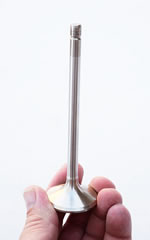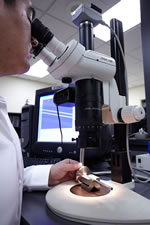Ruthless Pursuit of Power: The Mystique of the C6 Corvette LS7 Engine - Page 19 of 26
Ruthless Pursuit of Power: Lucky Seven Edition: The Mystique of the 7-Liter, 7000-RPM, LS7 - Page 19 of 26
 |
 |
by Hib Halverson
© May 2013— Updated: February 2016
No use without permission, All Rights Reserved
Unloved by Some: The LS7 Exhaust Valve
Our second head service source states emphatically that the root cause of exhaust valve guide wear, regardless of the accuracy of the head's machining, is excessive heat transferred to the guide by the LS7's sodium-filled exhaust valve stem. According to this source, the sodium-cooled valve actually works "too well". It moves too much heat to the guide. That, in turn, "cooks" the oil, turning it into a crusty, abrasive coke. Then the guide begins to wear due to abrasion and lack of oil. As the stem-to-guide clearance increases, the guide runs even hotter, the wear rate increases even further. If the problem is not addressed, the end result is failure of the valve.
Our research found that, while there are strong opinions about LS7's sodium-filled, hollow-stem exhaust valves causing valve guide wear, a preponderance of evidence to support that theory is lacking. One problem with this theory is it doesn't seem to work well with engines which have failed valve guides but have never seen extreme duty and thus, have not experienced oil temperatures in the guides high enough to cause "coking".
There is evidence that, if an LS7's heads' exhaust seats and guides are not machined accurately and the engine runs for a while with that problem, the increased valve-stem-to-guide-clearance caused by accelerated guide wear inhibits heat transfer from the exhaust valve stem to the guide. Once that happens, the stem runs hot and, depending on what kind of engine oil is used and the oil temperature, oil between the stem and guide may begin to "coke." Once coking begins, the valve fails in the manner discussed above. Note that the problem begins with improperly machined guides and seats, not the LS7 exhaust valve.
The Corvette performance specialist to which we spoke feels that powdered metal valve guides and sodium-filled exhausts are not a problem in a properly-machined head, but when guides and seats have a level of non-concentricity such that accelerated guide wear begins and exhaust valve stem temperature begins to climb then, PM guides and sodium-cooled exhausts can become an aggravating factor. Eventually, badly worn guides and the resulting flexing of the valve head cause the exhaust valve to break.
Hollow-stem, sodium-cooled exhaust valves were developed in the early-1920s by the U.S. Army Air Corps. In the mid-'20s, production of sodium-cooled valves was commercialized by the Thompson Products Company which later became "TRW". Sodium-cooled exhaust valves became "huge" after Charles Lindbergh used them in the Wright J5 "Whirlwind" nine-cylinder radial engine which powered the "Spirit of St. Louis", the first airplane to fly non-stop across the Atlantic Ocean in 1927. They have been widely used in reciprocating aircraft engines since then.
An early automotive application of sodium-cooled exhaust valves were in Dodge medium- and heavy-duty truck engines of the late-1940s and they've been used in truck engines, both gasoline and diesel, on a regular basis ever since. In the mid-60s, Ford was an early adopter of them for high-performance applications in the 427 cubic inch, "High-Riser", "Tunnel-Port" and SOHC V8s and the 302 "BOSS" V8 used in road racing, NASCAR and drag racing. After that, sodium-filled valves were occasionally used in production applications. Besides Ford in the U.S., Ford Europe, Fiat, Ferrari, Opel, Porsche, Alfa-Romeo, BMW, Mercedes, Toyota and Volkswagen are notable examples from the past of their use in light-duty engines.
One fact tending to dispel the idea that LS7's sodium-cooled valve causes exhaust guide wear is that sodium exhausts were in the LS6 and are in the LSA, a supercharged 6.2L V8 used in both 5th-gen Chevrolet Camaros and Cadillac CTS-Vs, neither of which have a history of valve guide problems. If premature guide failure was caused by sodium-cooled valves, those two engines would exhibit widespread excessive guide wear and, in the case of the '02-'04 LS6, we would have known about the problem before the LS7 came along. Also, not all LS7 engines experience problems with valve guides. If the problem was caused by the sodium-cooled exhaust valve itself, it is likely problems with valve guide wear would occur in a greater majority of the engines.
Research sodium-cooled exhaust valves and you'll find lots of contemporary high-performance applications which use them, including many turbocharged engines which generate exhaust temperatures higher than the LS7, and–there are no special design considerations for guide cooling in those engines. In addition to the 2006-2013 Z06, examples are: various Mercedes/AMG products and even some Mercedes SUVs, Mini John Cooper Works, Lexus IF-S, Nissan GT-R, Porsche Carrera GT, Audi A8, R8 and TT RS, BMW M3, M5 and M6, Dodge Viper, Dodge Charger and Challenger Hellcats, Ford Mustang (V8s and the "EcoBoost" 4-cyl), C5 Corvette Z06 (LS6), C6 ZR1 (LS9), C7 Corvette (LT1, LT4), Camaro ZL1 (LSA), Cadillac CTS-V (LS6, LSA, LT4), Cadillac XTS (LF3, 3.6L, V6 twin-turbo), Cadillac ATS-V (LF4, 3.6L V6TT), and the Cadillac CT6 (LGW 3.0L V6TT). Such wide usage begs the question: if sodium-cooled stems cause valve guide failures, then why are there not vast numbers of current performance cars made by many different manufacturers exhibiting widespread instances of premature valve guide wear?
Both Katech, Inc and the other engine development firm we polled stated that sodium-filled exhaust valves are not at the root of the guide wear problem. In fact, the Chief Engineer at one of them flatly stated, "Those who suggest the LS7's sodium-filled exhaust valves cause guide wear do not understand how they work."
Questioned by Others: the LS7 Intake Valve
As you will see later in this article, there have been problems with non-concentricity of intake guides and seats causing premature intake guide failure. Additionally, one of the cylinder head businesses which we interviewed told us that it has regularly observed excessive intake guide wear LS7 heads which have been frequently run at high-rpm/high-load duty cycles and it believes GM Powertrain's specification for the finish of the intake valve stem was not smooth enough.
When GM issued specifications to Del West for the Ti intake valve to be used in the C7 Z06's LT4, the stem finish requirement was more stringent than what was specified in the early '00s for the LS7 intake. To meet that requirement, Del West developed an additional manufacturing step, which Managing Director, Mark Sommer, described as a "super-finishing operation which processes the stem with an extremely fine grade of polishing media..." and improves the LT4 valve stem's surface finish beyond what GM required for the original LS7 intake valve. The difference between LS7 and LT4 intake valve stem finishes begs the questions: What drove GM's requirement of a better-quality finish on the stems of LT4 Ti intake valves? Does the fact that the LT4 intake stem needs super-finishing to be durable lend some credibility to the idea that an LS7, run in an aggressive, track use duty cycle, may experience a higher level of intake guide wear due to a stem surface finish deficiency? With the LS7 out of production and the class-action suit over guide wear making dialog with GM on some LS7 issues difficult, those questions remain unanswered...at least for now.
In late 2013, Del West converted all its titanium valves over to the super-finishing process and, as a result, LS7 heads assembled after early 2014 had super-finished intake valves. Del West also offers the process on an aftermarket basis. The head service cited above told us in an interview in early 2014 that it had been sending new GM intake valves, produced before the development of the super-finishing step, back to Del West to have their stem finishes enhanced. Del West told us recently that it can even do the process to a used valve which is in good condition.
 |
 |


